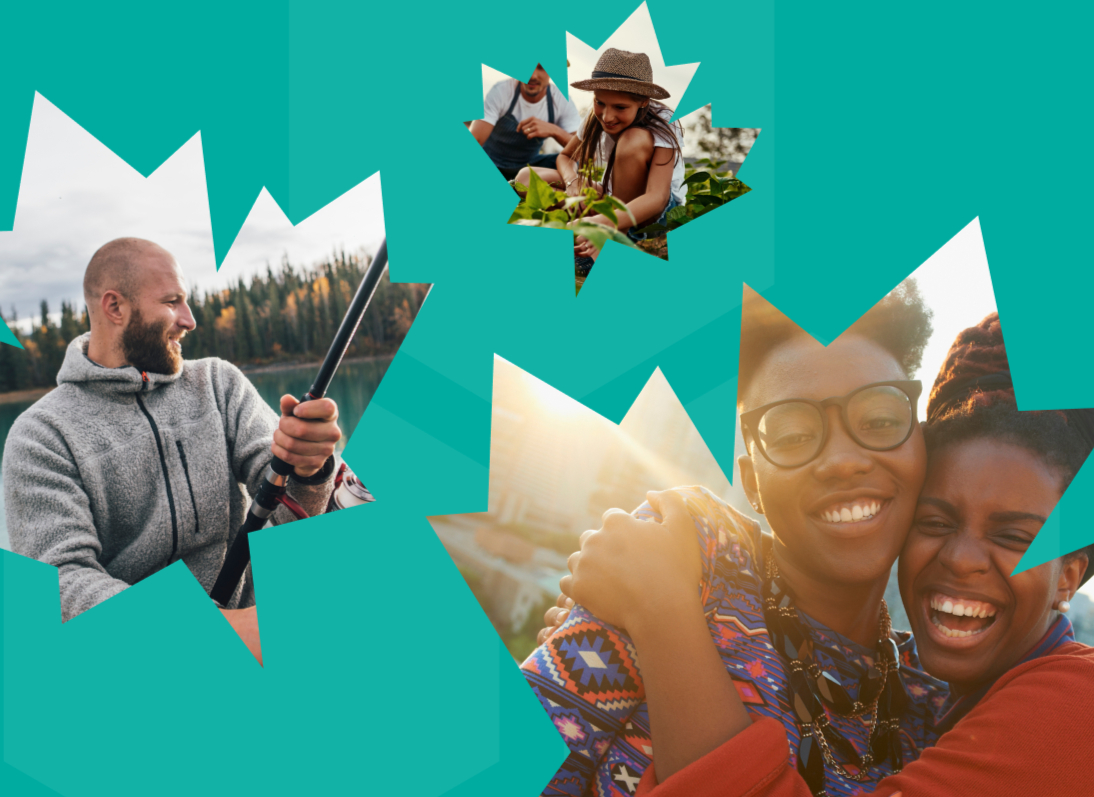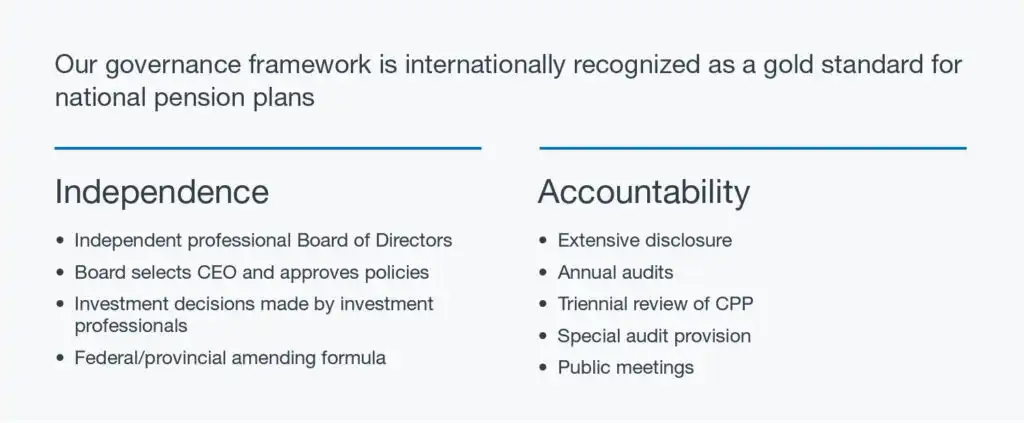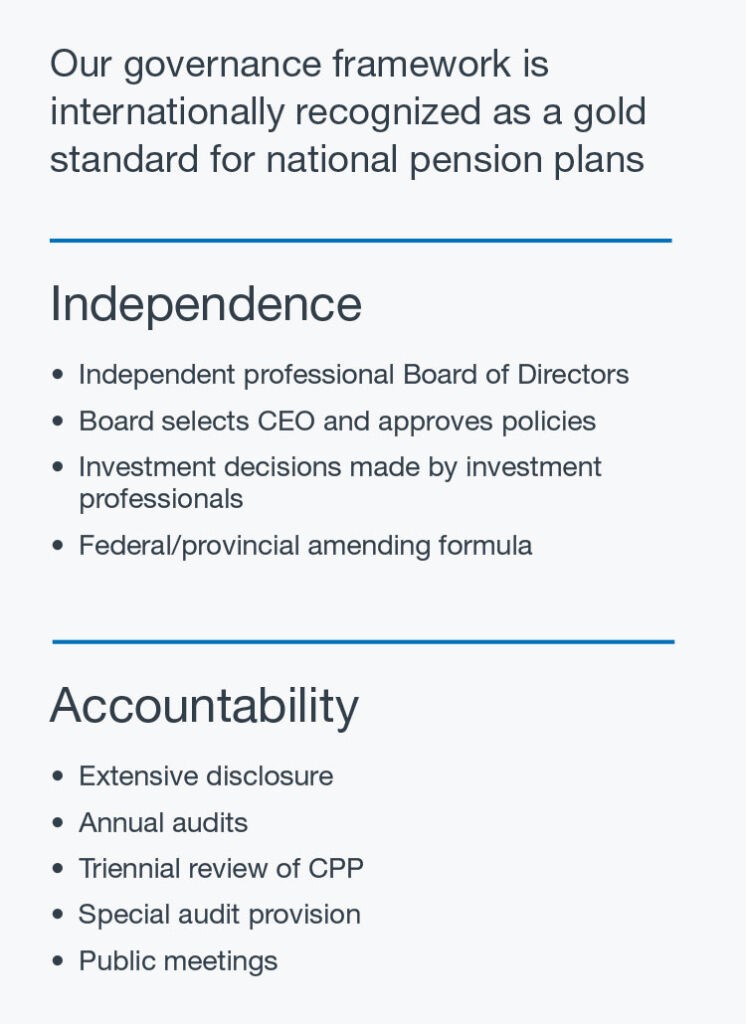Unless it’s about hockey or maple syrup, Canadians generally tend towards modesty. But after establishing one of the world’s most successful pension models, our country has reason enough to boast.
Despite being only the 38th largest country by population, Canada has the third largest share of pension wealth.1 Remarkably, Canada had eight of the world’s 100 biggest pension funds in 2021, including the Canada Pension Plan (CPP) Fund – the seventh largest pension fund globally.2
We’re one of the few countries on the planet that has a solvent pension plan, and we have one of the best performing pension funds globally. The CPP Fund, which is professionally managed by the Canada Pension Plan Investment Board (CPPIB), or CPP Investments, was recently named the world’s top-ranked fund on governance and among the very best on transparency and cost.3
“[Canada] has only the world’s ninth-largest economy, but its pension system has proven to be one of, if not the, most advanced,” the Global SWF 2021 Annual Report says.
It’s our distinctly Canadian approach to pension fund management that sets us apart globally.
In Canada, many pension programs have separate investment arms that operate as independent entities to manage capital and build wealth. This model includes running internal portfolios and investing directly in private assets.
Rather than relying exclusively on external money managers, investing decisions are informed by teams of internal and external experts, delivering cost savings while ensuring a diversity of perspectives. Investments are broadly made in diversified assets beyond stocks and bonds, including private companies, real estate and infrastructure – opportunities that are normally not available to smaller investors.
At CPP Investments, we invest the funds not currently needed to pay benefits in an effort to grow the CPP Fund on behalf of working Canadians. Our prudent and patient approach to investing targets strong returns for steady growth over the long term.
By pooling capital from the millions of CPP contributors across the country, we’re able to fully leverage our size and scale, creating a global investment powerhouse. Canadians come together to create something bigger so that we all share the risks and rewards that come with investing our hard-earned money.
From Wall Street to Main Street, the world has taken notice of our success. Canadian pension fund managers, including CPP Investments, have been labelled “maple revolutionaries” for their distinct and effective approach to pension fund management, earning praise from industry experts.
“The CPPIB is an investment force to be reckoned with,” The Economist wrote in 2019. “Its performance matters beyond Canada not just because of its holdings of global assets, but because many other countries, with their ageing populations and poorly funded pension schemes, might hope to draw lessons from it.”
But like most success stories, it didn’t happen overnight.
When the CPP was created in 1966, the aim was to provide working Canadians with a solid financial foundation in retirement. At the time, there were enough workers to sustain the CPP solely through contributions.
As Canada’s demographics and economy evolved, so did the CPP Fund. Lower birth rates, higher life expectancies, fewer workers and contribution rates that didn’t rise to compensate for these changes severely impacted the CPP’s finances. By the 1990s, alarm bells were ringing over the CPP Fund, which was running out of money, as shown in the Chief Actuary’s 1995 report. This reality was shared with Paul Martin, Canada’s finance minister at the time.
“What was happening was the amounts of money being paid in premiums relative to the benefits were clearly insufficient to cover the payout,” Martin explained. “As a result, the pension fund started getting into bigger and bigger deficit.” The Chief Actuary’s report found if no changes were made, the CPP Fund would be exhausted by the end of 2015.
In 1997, the federal and provincial governments agreed to major CPP reforms, including the increase of contribution rates. They also created an independent investment board to manage and build the CPP Fund on behalf of working Canadians. They came together with a common goal – to ensure retirement security for future generations of Canadians.
“Instead of it being an issue of considerable contention in Canada, [the CPP] became a beacon of confidence for young Canadians and for senior Canadians,” Martin said.
In 2006, CPP Investments decided to adopt an active management strategy to help improve overall returns for the CPP Fund. This decision enabled our investors to seek out opportunities for above-market returns over the long term in an effort to manage the Fund in the best interests of contributors and beneficiaries.
The move helped grow the CPP Fund from $100 billion in 2006 to more than $570 billion in 2023. Today, CPP Investments holds investments in 55 countries, resulting in a 10-year cumulative net income of $311 billion with an annualized net return of 9.6%, as shown in our Q2 Fiscal 2024 results.
At CPP Investments, we have a clear objective: to maximize long-term investment returns without undue risk of loss. In addition, we invest without any political interference in our decision-making, overseen by an independent Board of Directors. This allows us to pursue the best investment opportunities around the world.
CPP Investments is different from many other large institutional investors because of the enduring nature of the CPP and the CPP Fund, our governance, our culture and the strategic choices we make. Together, these comparative advantages drive our global competitiveness and maximize long-term returns for the CPP Fund.
The single largest financial risk we all face is not having sufficient retirement savings. As Canadians live to be older than ever, it’s important to have adequate finances to maintain a standard of living. It’s comforting for Canadians to know that the CPP will be there for them with financial support in retirement. Not everyone is so fortunate.
In the U.S., where Social Security provides retirement benefits for qualified beneficiaries, funds are projected to run out by 2035, potentially leaving millions of Americans without enough funds for retirement. Developed countries like South Korea, Japan and the U.K. face their own pension challenges, as well. That could be why some worry that we may face a similar predicament in Canada, despite the CPP’s success.
However, every three years, the Office of the Chief Actuary of Canada, an independent federal body that assesses the state of the plan. The most recent review, completed in December 2022, concluded that the CPP will continue to be sustainable for 75 years and beyond.
There’s a lot to like about our pension fund model. It provides millions of people with the sound and secure financial assistance they need in retirement and is intended to deliver benefits today, tomorrow and for decades to come. It was made by Canadians, for Canadians. And it really works.
Unless it’s about hockey or maple syrup, Canadians generally tend towards modesty. But after establishing one of the world’s most successful pension models, our country has reason enough to boast. Despite being only the 38th largest country by population, Canada has the third largest share of pension wealth.1 Remarkably, Canada had eight of the world’s 100 biggest pension funds in 2021, including the Canada Pension Plan (CPP) Fund – the seventh largest pension fund globally.2 We’re one of the few countries on the planet that has a solvent pension plan, and we have one of the best performing pension funds globally. The CPP Fund, which is professionally managed by the Canada Pension Plan Investment Board (CPPIB), or CPP Investments, was recently named the world’s top-ranked fund on governance and among the very best on transparency and cost.3 “[Canada] has only the world’s ninth-largest economy, but its pension system has proven to be one of, if not the, most advanced,” the Global SWF 2021 Annual Report says. It’s our distinctly Canadian approach to pension fund management that sets us apart globally. How does it work? In Canada, many pension programs have separate investment arms that operate as independent entities to manage capital and build wealth. This model includes running internal portfolios and investing directly in private assets. Rather than relying exclusively on external money managers, investing decisions are informed by teams of internal and external experts, delivering cost savings while ensuring a diversity of perspectives. Investments are broadly made in diversified assets beyond stocks and bonds, including private companies, real estate and infrastructure – opportunities that are normally not available to smaller investors. At CPP Investments, we invest the funds not currently needed to pay benefits in an effort to grow the CPP Fund on behalf of working Canadians. Our prudent and patient approach to investing targets strong returns for steady growth over the long term. By pooling capital from the millions of CPP contributors across the country, we’re able to fully leverage our size and scale, creating a global investment powerhouse. Canadians come together to create something bigger so that we all share the risks and rewards that come with investing our hard-earned money. From Wall Street to Main Street, the world has taken notice of our success. Canadian pension fund managers, including CPP Investments, have been labelled “maple revolutionaries” for their distinct and effective approach to pension fund management, earning praise from industry experts. “The CPPIB is an investment force to be reckoned with,” The Economist wrote in 2019. “Its performance matters beyond Canada not just because of its holdings of global assets, but because many other countries, with their ageing populations and poorly funded pension schemes, might hope to draw lessons from it.” But like most success stories, it didn’t happen overnight. How it started When the CPP was created in 1966, the aim was to provide working Canadians with a solid financial foundation in retirement. At the time, there were enough workers to sustain the CPP solely through contributions. As Canada’s demographics and economy evolved, so did the CPP Fund. Lower birth rates, higher life expectancies, fewer workers and contribution rates that didn’t rise to compensate for these changes severely impacted the CPP’s finances. By the 1990s, alarm bells were ringing over the CPP Fund, which was running out of money, as shown in the Chief Actuary’s 1995 report. This reality was shared with Paul Martin, Canada’s finance minister at the time. “What was happening was the amounts of money being paid in premiums relative to the benefits were clearly insufficient to cover the payout,” Martin explained. “As a result, the pension fund started getting into bigger and bigger deficit.” The Chief Actuary’s report found if no changes were made, the CPP Fund would be exhausted by the end of 2015. In 1997, the federal and provincial governments agreed to major CPP reforms, including the increase of contribution rates. They also created an independent investment board to manage and build the CPP Fund on behalf of working Canadians. They came together with a common goal – to ensure retirement security for future generations of Canadians. “Instead of it being an issue of considerable contention in Canada, [the CPP] became a beacon of confidence for young Canadians and for senior Canadians,” Martin said. In 2006, CPP Investments decided to adopt an active management strategy to help improve overall returns for the CPP Fund. This decision enabled our investors to seek out opportunities for above-market returns over the long term in an effort to manage the Fund in the best interests of contributors and beneficiaries. The move helped grow the CPP Fund from $100 billion in 2006 to more than $570 billion in 2023. Today, CPP Investments holds investments in 55 countries, resulting in a 10-year cumulative net income of $311 billion with an annualized net return of 9.6%, as shown in our Q2 Fiscal 2024 results. What sets the CPP apart At CPP Investments, we have a clear objective: to maximize long-term investment returns without undue risk of loss. In addition, we invest without any political interference in our decision-making, overseen by an independent Board of Directors. This allows us to pursue the best investment opportunities around the world. CPP Investments is different from many other large institutional investors because of the enduring nature of the CPP and the CPP Fund, our governance, our culture and the strategic choices we make. Together, these comparative advantages drive our global competitiveness and maximize long-term returns for the CPP Fund. Uniquely Canadian The single largest financial risk we all face is not having sufficient retirement savings. As Canadians live to be older than ever, it’s important to have adequate finances to maintain a standard of living. It’s comforting for Canadians to know that the CPP will be there for them with financial support in retirement. Not everyone is so fortunate. In the U.S., where Social Security provides retirement benefits for qualified beneficiaries, funds are projected to run out by 2035, potentially leaving millions of Americans without enough funds for retirement. Developed countries like South Korea, Japan and the U.K. face their own pension challenges, as well. That could be why some worry that we may face a similar predicament in Canada, despite the CPP’s success. However, every three years, the Office of the Chief Actuary of Canada, an independent federal body that assesses the state of the plan. The most recent review, completed in December 2022, concluded that the CPP will continue to be sustainable for 75 years and beyond. There’s a lot to like about our pension fund model. It provides millions of people with the sound and secure financial assistance they need in retirement and is intended to deliver benefits today, tomorrow and for decades to come. It was made by Canadians, for Canadians. And it really works. 1 Thinking Ahead Institute 2023 Global Pension Assets Study2 Thinking Ahead Institute and Pensions & Investments 2022 Global top 300 pension funds joint study3 Top1000funds.com and CEM Benchmarking 2023 Global Pension Transparency Benchmark








